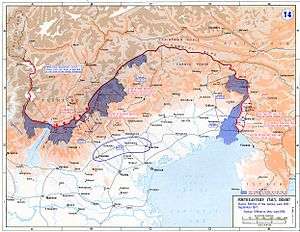Third Battle of the Isonzo
| Third Battle of the Isonzo | |||||||
|---|---|---|---|---|---|---|---|
| Part of the Italian Front (World War I) | |||||||
 Eleven Battles of the Isonzo June 1915 – September 1917 | |||||||
| |||||||
| Belligerents | |||||||
|
|
| ||||||
| Commanders and leaders | |||||||
|
Luigi Cadorna, Emanuele Filiberto, 2nd Duke of Aosta |
Svetozar Boroević, Archduke Eugen of Austria | ||||||
| Strength | |||||||
| 338 battalions, 130 cavalry squadrons, 1,372 artillery pieces | 137 battalions (plus 47 battalions of reinforcements), 634 artillery pieces. | ||||||
| Casualties and losses | |||||||
| 67,100 (11,000 dead) | 40,400 (9,000 dead) | ||||||
The Third Battle of the Isonzo was fought from 18 October through 3 November 1915 between the armies of Italy and Austria-Hungary.
Background
After roughly two and a half months of reprieve to recuperate from the casualties incurred from frontal assaults from the First and Second Battle of the Isonzo, Luigi Cadorna, Italian commander-in-chief, understood that artillery played a fundamental role on the front and brought the total number to 1,200 pieces.
The main objectives were to take the Austro-Hungarian bridgeheads at Bovec (Plezzo in Italian) and Tolmin, if possible the town of Gorizia. Cadorna's tactic, of deploying his forces evenly along the entire Soča (Isonzo), proved indecisive. The Austro-Hungarians took advantage of the relatively small areas of attack to concentrate their firepower on those areas.
Battle
Thanks to extensive artillery barrages, the Italians were able to advance to Plave (Plava in Italian) near Kanal ob Soči, beneath the southern end of the Banjšice Plateau (Bainsizza), and on Mount San Michele on the Kras plateau in an attempt to outflank those forces defending Gorizia. The plateau near San Michele was the scene of heavy attacks and counterattacks involving the Italian Third Army and Austro-Hungarian reinforcements from the Eastern and Balkan fronts under the command of Svetozar Boroević; both sides suffering heavy casualties.
Thanks to the low profile held by Boroević's forces, the Austrians were able to hold their positions with heavy casualties, inferior however to those of the Italians. This battle showed Boroević's tactical brilliance despite the limited scope of the front.
The lull in action lasted barely two weeks after which the Italian offensive started anew. [1][2]
See also
- First Battle of the Isonzo - 23 June–7 July 1915
- Second Battle of the Isonzo - 18 July–3 August 1915
- Fourth Battle of the Isonzo - 10 November–2 December 1915
- Fifth Battle of the Isonzo - 9 March–17 March 1916
- Sixth Battle of the Isonzo - 6 August–17 August 1916
- Seventh Battle of the Isonzo - 14 September–17 September 1916
- Eighth Battle of the Isonzo - 10 October–12 October 1916
- Ninth Battle of the Isonzo - 1 November–4 November 1916
- Tenth Battle of the Isonzo - 12 May–8 June 1917
- Eleventh Battle of the Isonzo - 19 August–12 September 1917
- Twelfth Battle of the Isonzo - 24 October–7 November 1917 also known as the Battle of Caporetto
References
Further reading
- Macdonald, John, and Željko Cimprič. Caporetto and the Isonzo Campaign: The Italian Front, 1915-1918. Barnsley, South Yorkshire: Pen & Sword Military, 2011. ISBN 9781848846715 OCLC 774957786
- Schindler, John R. (2001). Isonzo: The Forgotten Sacrifice of the Great War. Praeger. ISBN 0275972046. OCLC 44681903.
External links
- Battlefield Maps: Italian Front
- 11 battles at the Isonzo
- The Walks of Peace in the Soča Region Foundation. The Foundation preserves, restores and presents the historical and cultural heritage of the First World War in the area of the Isonzo Front for the study, tourist and educational purposes.
- The Kobarid Museum (in English)
- Društvo Soška Fronta (in Slovenian)
- Pro Hereditate - extensive site (in En/It/Sl)
Further reading
- Bauer, E., 1985: Der Lowe vom Isonzo, Feldmarschall Svetozar Boroević de Bojna. Aufl. Styria. Graz
- Boroević, S., 1923: O vojni proti Italiji (prevod iz nemškega jezika). Ljubljana
- Comando supremo R.E. Italiano, 1916: Addestramento della fanteria al combattimento. Roma. Tipografia del Senato
Coordinates: 45°51′24″N 13°24′01″E / 45.85667°N 13.40028°E